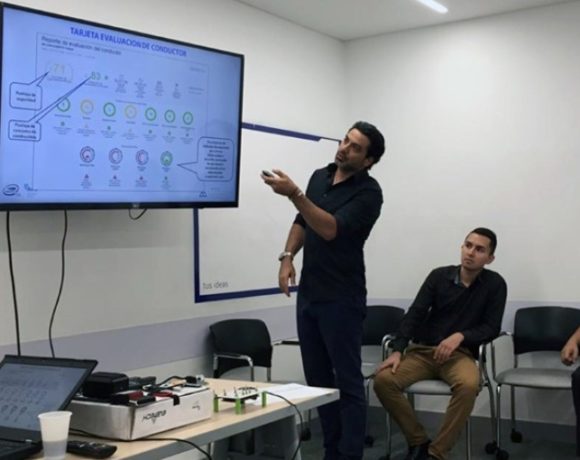Interview: Ruta N a High-Tech Investment Opportunity, Part 2

Medellin’s novel “Ruta N” high-tech development center next to Universidad de Antioquia now boasts that it’s hosting some 135-odd companies from 22 countries (see http://distritomedellin.org/hacer-parte/) that have chosen to locate inside Ruta N itself or nearby.
In an exclusive interview with Medellin Herald, Ruta N Executive Director Alejandro Franco and Ruta N “knowledge-business” development chief Eduardo Quiroz explained the concepts, projects and investment opportunities at Ruta N (see ‘Interview: Ruta N a High-Tech Investment Opportunity, but don’t Call it a ‘Silicon Valley, Part 1’ Medellin Herald, 16 July 2016).
Here is the second part of that interview:
Medellin Herald: A recent study co-sponsored by JP Morgan, Endeavor and Corporacion Las Mercedes found that the principal obstacle for the development of a stronger IT industry in Medellin specifically and Colombia generally is the lack of qualified technical personnel. The study found that Colombia will lack some 93,000 trained IT professionals by 2018. Therefore, doesn’t it make sense for Ruta N to concentrate more on developing IT professionals, rather than focusing upon so many different elements?
Quiroz: The problem of talent is not a problem of Medellin. It is a global problem. It’s like having gold: we would like to have more, but maybe we have more than the rest of the world.
Yesterday [July 12] for example we witnessed the relaunch of Yuxi Pacific – a U.S. company that has all of its global IT operations based here in Medellin. They’ve grown from 20 employees to having 100 employees in less than three years.
I was talking with the president of the company and the major investor in that company, and I was told that they can find talent in Medellin that they cannot find anywhere else . . . Obviously there are people [in the U.S.] who have the talent, but they’re not available to Yuxi.
In Colombia it is not easy finding such talent, but you can get it. The Medellin office of Yuxi has 100 employees now and they expect to create 200 new jobs here for developers.
I was told by them that in their vision for the future, Colombia is the best country for various reasons as a favorable place for business development in Latin America. Once you decide that Colombia is the best country, then you have to decide which city you go to establish, and they think that Medellin is the most suitable city because you can find capital, talent and a series of other elements.
When the president of Yuxi talked to me about this, he told me, ‘Eduardo this is already happening, and we are doing very well. In meetings with my allies, my partners, always Medellin is in the center of the conversation, there is always the discussion of how we invest more and which products we will sell,’ and he’s pushing new projects . . .
This tells me that we’re going in the right direction.
The problem of [sufficient, qualified] talent is a problem — but it’s a problem like so many other problems in the world, such as mobility and security. We clearly do not have all the talent we want, but we have a very interesting offer, because we offer comparable quality with what you can find in San Francisco, or if you go to China, there you can get talent, but maybe not comparable and not necessarily cheap, not the cheapest.
Talent with quality that’s very affordable and with very good capabilities make these organizations come here. They are coming here to settle.
So first, the talent, we would like to have more. Second, [the mission of] Route N is not [exclusively] to train people, it’s to encourage and foster conditions so that there is more talent [attracted here].
We have concrete actions for the attraction of talent from anywhere, and a favorable ecosystem is bringing these opportunities for business development and work.
Programs we have that have been supremely successful to close the gap for professionals here include “Coderice.” We have some ‘boot-camps’ where we are training talent that enables students in a few months to produce software with a quality comparable to world standards.
Franco: There are specific programs that we are doing to accelerate and prepare young people of Medellin and develop skills in these IT areas that later will support the strengthening of the local [IT] industry.
The ‘boot-camps’ are short programs that we have designed for young people to rapidly acquire the capacity and undertake specific development of software for development conditions.
In the last six months we have trained more than 150 young people in courses taking about 180 hours for specific competence in software development — and some of these young people are quickly absorbed by the demands of the labor market.
The first cut [those passing the boot-camp course] was late last year. Of those [initial 150 students], 23 finished successfully, and 19 of them are already employed, while three others have launched their own businesses.
A second program involving the World Bank and our local Youth Secretariat inscribed 900 young students, and we’re now working with 150 of those students . . .
Among the medium-term strategies and programs with which we have been very successful are the “Horizontes Aca” [‘Horizons Here’] program and the ‘Innova Campus’ program.
With ‘Horizontes Aca,’ we are looking to train young people between the ages of 13 and 19 in competencies covering science, technology, engineering and mathematics.
Under this program, between 2014 and 2015 — and now in 2016 — more than 7,500 young people already have established familiarity with robotics, with the development of software, with experimentation, with working together in a laboratory.
The ‘Innova Campos’ program with Purdue University here is designed to impact institutions of higher education, where we want them to be perceived as ‘innovation parks,’ to get institutions to apply innovation not only in their curriculums but also in the process of knowledge transfer to the market. We’re seeing growth rates between 10% and 30% annually [for ‘Innova Campos’ programs]. I think that’s a response to what you’re telling us: we are preparing to meet this demand for trained personnel in the competencies being demanded.
Medellin Herald: These programs are also coordinated with local universities here?
Franco: They are all articulated programs with our ecosystem actors, in this case involving related institutions of higher education including the University of Medellin, the Fundacion CEIBA, the Colegio Salazar and Herrera, the CES.
Quiroz: These programs can be seen as something like a ‘finishing school.’ Universities [and other institutes] can educate students in basic structural capabilities. This leaves the ‘finishing school’ to make the student ready for industry.
Medellin Herald: Another recent study co-sponsored by Ruta N and Endeavor found that Medellin lacks enough “angel investors” to patronize more IT start-ups here. What can Ruta N do to attract more “angel investors” to Medellin?
Quiroz: First, I would invite you to consult in-depth something we call the ‘inversometro,’ which you can find at www.Inversometro.org.
The ‘inversometro’ is a study that we do annually of the dynamics of the venture-capital industry here. That report is generated by Route N, but with information that comes directly from the various fund managers and angel investors in the city. Today we have on the order of COP$530,000 million [US$180 million] from all the [funding] mechanisms we have in the city.
And of those COP$530,000 million, there is a certain participation corresponding to angel investors.
It is clear that we want more angel investors and this is a resource that should be strengthened. What are we doing for that? We do the annual ‘inversometro,’ which is the result of that evolution of the venture capital industry.
What we do annually can be seen as the last stage of the management of the network, measuring and connecting the ‘capital intelligence’ of this city. An intelligent capital network is an initiative to connect all managers of venture capital or capital for those who finance innovation.
We sit down, we connect, we know them all and we define a strategic agenda. We also have a second element that is to help develop that agenda. Normally we find issues on that agenda such as ‘strengthen capacities in fundraising,’ how to value companies, how to do due-diligence, and investment management . . .
We also identify what other mechanisms of investment are needed and how to stimulate their creation, so that others come here and develop lines of fundraising . . . For example, with Social Atom Ventures, which is one of our allies, last year we developed a program called “Angel Partners,” where they develop capacities to chase new angel investors.
The idea is to create a virtuous circle, whereby today I have six investors, tomorrow I have 36, and later I have 100 . . .
With our ‘inversometro,’ we’re planning to go from COP$530,000 million to COP$1 trillion [US$340 million] by 2021, and all of this is private capital.
To achieve this, first, we’re connecting investors. Second, we’re developing a strategic agenda to fortify their capacities and make them better investors. Third, we’re opening the door for business opportunities, by showing them [new IT] projects, or projects that haven’t taken-off yet for whatever reason . . .
Fourth, we study the dynamics of the venture-capital industry in the city. With this integral strategy, we are developing and evolving our venture-capital, where angel investors are part of that strategy.
Franco: To summarize, Ruta N is leading a network of ‘smart’ capital that connects the different fund managers and their different mechanisms of investment. Without doubt, we are helping to connect and develop new investors who come here to our city. To do that, we do different actions, from training, to investing in start-ups, as well as introducing local entrepreneurs to investors in new projects.
Medellin Herald: On the other hand, the founder of one very successful IT start-up here in Medellin — Kogi Mobile — has been critical of Ruta N (see ‘Medellin Developing IT Start-ups, but Sharper Focus Needed,’ Medellin Herald, 27 October 2015).
Kogi’s founder, Nick Aldridge, has described Ruta N as like to a government-funded cornfield where ‘locusts’ [opportunists] arrive and consume most of the available IT resources and talent, then later move on to someplace else, leaving nothing behind. Is this a valid criticism? Could Ruta N be viewed as a sort of ‘unfair competition’ to private IT entrepreneurs that have longer-term visions and no connection to government-funded Ruta N? Do these private entrepreneurs face unfair competition with Ruta N-connected companies on salaries, infrastructure, etcetera?
Franco: We respect such criticism and welcome such analysis . . . But our goal is to accelerate the transformation of Medellin from a city based upon a traditional economy to a knowledge-based economy, including start-ups and technology-based companies, supplemented by a plan of science, technology and innovation, which can make it all happen. We aren’t really competing [with private, independent start-ups such as Kogi] because we’re channeling the resources of the municipality to quickly impact the economy of the city and encourage the growth of more and new businesses, and consolidate existing businesses. We’re not competing, because what we are trying to do is articulate actors, based on knowledge, to provide solutions to the problems of our city, which will allow us to prepare for future challenges.
















